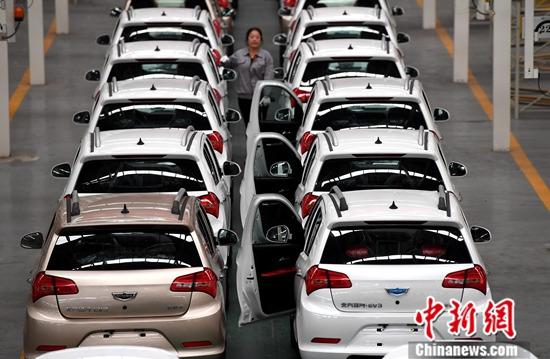The data picture shows Yong'an City, Fujian Province, staff working on the production line of Zhongke Power (Fujian) New Energy Automobile Co., Ltd.
Photo by China News Agency reporter Zhang Bin
(Economic Observation) What changes will happen to China's new energy automobile industry in the next 15 years?
China News Service, Beijing, December 18th. Title: What will happen to China's new energy automobile industry in the next 15 years?
China News Agency reporter Liu Yuying
The automotive industry has entered an era of major changes unseen in a century.
In the next 15 years, China's new energy automobile industry is expected to be greatly improved in terms of key core technologies, infrastructure, service models, and industrial ecology.
Pure electric vehicles will become the mainstream of new car sales in 2035
The "New Energy Vehicle Industry Development Plan (2021-2035)" released in October this year clearly stated that the sales market for new energy vehicles will account for about 20% in 2025, and pure electric vehicles will become the mainstream of new sales vehicles in 2035.
In the first 11 months of 2020, 1.109 million new energy vehicles were sold in the Chinese market, a year-on-year increase of 3.9%.
Ma Chunsheng, deputy director of the Automobile Development Division of the Equipment Industry Division I of the Ministry of Industry and Information Technology, said at the Industry and Information Salon recently that the new energy vehicle market has undergone gratifying changes this year. First, the proportion of personal consumption has increased significantly, reaching 70%; second, non-restricted purchases The proportion of urban purchases reached 60%.
In addition, nearly 200,000 new energy vehicles are sold to the countryside.
All this shows that the acceptance of new energy vehicles has greatly improved.
Ma Chunsheng said that industry enterprises define this year as the first year of market-oriented development, and the entire industry has entered a new stage.
Autonomous driving will achieve large-scale applications in 2035
The plan also proposes that in 2035, highly automated driving will achieve large-scale applications.
In 2020, cities such as Beijing and Changsha will launch test applications for self-driving taxis; Shanghai will launch the application of heavy-duty trucks between ports.
The Ministry of Industry and Information Technology has established a National Intelligent Connected Vehicle Innovation Center to support the construction of demonstration zones in more than ten places across the country, and autonomous driving tests and demonstrations are being carried out in various places.
Ma Chunsheng said that among the newly launched models, models with conditional automatic driving systems account for nearly 15%.
The next step is to focus on promoting the coordinated development of electrification, connectivity, and intelligent integration, including focusing on standards, accelerating the development of connectivity, deepening testing and demonstration, and optimizing the industrial ecology.
Charging facilities: slow charging as the mainstay, fast charging and battery replacement as a supplement
Hou Fushen, deputy secretary-general of the Chinese Society of Automotive Engineers, said that according to the prediction of the energy-saving and new energy vehicle technology roadmap (version 2.0), the future will still be a system with slow charging as the mainstay, fast charging and battery swap as a supplement.
It is predicted that by 2025, the charging pile ports for slow charging will reach more than 13 million terminals, including private users’ own piles and public piles, and public fast charging will reach 800,000 terminals.
There were 300 replacement power stations at the end of 2019, and it is expected to reach 3,000 in 2025, an increase of 10 times.
Ye Shengji, deputy secretary-general of the China Association of Automobile Manufacturers, said that the market already has the basic conditions to carry out trials of vehicle-electric separation and battery exchange models.
It is estimated that by 2025, the application of car-electric separation and split-point mode will be promoted from the public domain to the private application domain with good results.
Core technology: reach the international advanced level by 2035
The plan proposes that after 15 years of continuous efforts, the core technology of China's new energy vehicles will reach the international advanced level, and the quality brand will have strong international competitiveness.
The plan has determined the "three vertical and three horizontal" R&D layout.
The "three verticals" refer to pure electric vehicles, plug-in hybrids, and fuel cell vehicles, and the "three horizontals" refer to power batteries and management systems, drive motors and power electronics, networked and intelligent technologies.
Hou Fushen said that in terms of power battery energy density, China is now basically the same as the most advanced international level.
In terms of drive motors, the overall motor efficiency and reliability of the motor, Chinese companies are basically equivalent to the international advanced level.
Hou Fushen said that the stuck neck problem is concentrated on some basic parts, such as basic materials, basic processes, basic components, parts, etc., as well as some basic development tools, design software, simulation test software, etc.
Hou Fushen said that to tackle key problems, the technology needs policy support and must be driven by the market.
"The plan has released a clear signal that the future of automobiles will be transformed in the direction of electrification, intelligence, and connectivity, so that enterprises can rest assured and boldly invest."
(Finish)

